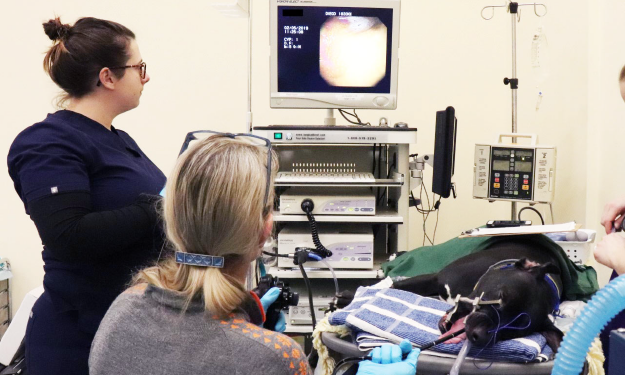Endoscopy for Dogs & Cats

Upper gastrointestinal (GI) endoscopy or esophagogastroduodenoscopy (EGD) is an important diagnostic technique for diseases of the upper GI tract in pets.
When Do We Use Endoscopy in Veterinary Medicine?
There are numerous indications for upper GI endoscopy including vomiting, regurgitation, diarrhea, lack of appetite, weight loss, evaluation of masses (tumors) and ulcers. Upper GI endoscopy can also be used therapeutically for removal of GI foreign bodies, dilation of esophageal strictures and removal of polyps in the stomach.
What is an Endoscope?
The video endoscopy unit is a state of the art piece of equipment with many components. The scope itself is a long, flexible tube which sends and receives light, and transmits the image onto a high resolution television screen. This enables the doctor to see inside the animal’s gastrointestinal tract. The scope has channels for biopsy forceps, retrieval forceps, and other accessories. In addition, the scope has capabilities for suction, and air/water instillation which allows the lens to be cleaned of debris.
How is an Endoscope Used on a Dog or Cat?
The scope is placed through the mouth into the stomach and small intestine. The doctor views the anatomy as the scope is passed, looking for any abnormalities. The doctor checks to see if the mucosal lining is of normal color and texture. The biopsy forceps are passed through the channel of the scope and tissue samples are taken from the stomach wall and different sites in the intestinal tract. If the doctor is removing a foreign object, retrieval instruments are passed through the scope or along side the scope to grasp objects and remove them from the GI tract.
Anesthesia & Care During an Endoscopy
An endoscopy technician will be monitoring the anesthesia as the doctor performed the procedure. Endoscopy requires that your pet receive an intravenous catheter and be placed under a general anesthetic. The animal’s heart rate is monitored using an EKG telemetry monitor, which evaluates cardiac rhythm. The technician monitors respiratory rate visually and additionally uses sophisticated blood pressure and pulse oximetry monitors to monitor blood oxygen level to assure the animal is receiving proper ventilation. The technician stays with the animal following the procedure until the pet is fully recovered from anesthesia.
How Long Does an An Endoscopy on My Pet Take?
The endoscopic procedure lasts approximately 30-60 minutes. Recovery from anesthesia is approximately another 15-20 minutes. We will usually keep your pet for the day to monitor for any post-procedural complications. If all has gone well with recovery, the animal can usually go home that evening.
What Happens After My Pet’s Endoscopy?
The biopsy samples are placed in formalin to preserve them during transport to the lab. They are sent to the Texas A&M GI Laboratory where the samples are evaluated by pathologists with special expertise in GI pathology. Biopsy results are available in approximately 5 working days. Upon discharge of your pet, discharge orders are sent home with you giving instructions for care until biopsy results come back.